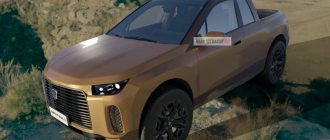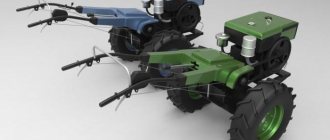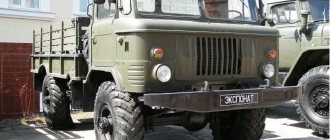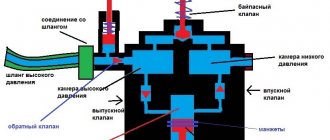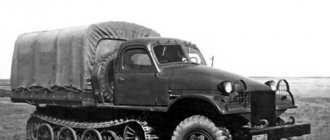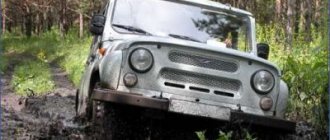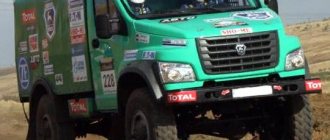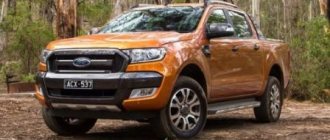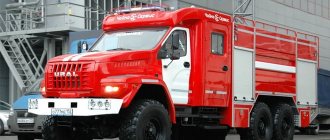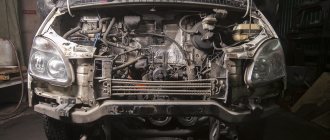Author: Lan, don’t growl
14 March 2016 13:12
Tags: GAZ-66 cars all-terrain vehicles SUVs
42531
18
It seems that turning a Shishiga into a Hummer has already become no less banal than reinventing the wheel. We tested the highlights of this specimen in real conditions and realized one thing: a living room on wheels can knead a swamp no worse than any other tank.
0
Source:
See all photos in the gallery
The highlight of this wonderful car is its luxurious interior. But we decided to test it as a banquet hall after everything, in the late afternoon. And to begin with, we made ourselves comfortable on his armchairs and sofas and went for a ride out of town.
Technique
0
Source:
To build a wheeled vehicle, there is no need to invent your own units, since there are enough industrially produced analogue vehicles. And these analogues are always ready to act as donors - for a smart designer, as they say, nothing is a pity. And although the conceptually new car was conceived in the likeness of a large passenger station wagon, the units for it were found to be truck-mounted: dimensions are a requirement. The GAZ-66 shared the frame, axles and transfer case. The engine was borrowed from the German Mercedes 609D truck (T2 version 1986) - it is an in-line low-speed naturally aspirated four-cylinder diesel engine OM364, delivering its maximum 90 hp. With. at 2,800 rpm. The gearbox, a five-speed manual, was also taken from the same Bundeswehr truck.
0
Source:
The steering wheel was equipped with a hydraulic booster with a pump, also from the “German”. Another truck, whose name remains unknown, gave the hunters its brakes - with a vacuum booster and a vacuum receiver. Looking ahead, I will note that all the mentioned servos are very effective, including in the most difficult conditions. The car's suspension is as simple as possible and, moreover, durable - a pair of continuous axles with leaf springs and wheels from GAZon.
0
Source:
Another borrowing is the body parts of the all-terrain vehicle, which used as many as four GAZ-66 cabins: doors with frames, glass, rear walls... What the Shishigi panels were not enough for (and this is the “skirt” of the body below the frame) was welded from stainless steel, since it was known in advance that the car would undergo frequent bathing.
0
Source:
0
Source:
0
Source:
The roof, reinforced with a steel frame, turned out to be strong enough to accommodate a trunk, to which a folding ladder had to be laid. In the area of the front seats there is a wide hatch through which it is convenient to look around the area from the height of the car. Next to it is a searchlight controlled from the interior.
The engine is the heart of the car
The engine is the most important thing in a car, and it needs to be treated with care and responsibility.
In order for our supercar not to fail off-road, we need to pay enough attention to the condition of the engine and, if necessary, replace it. The most popular and affordable engine for Shishiga on today's market is a diesel engine produced at the Minsk Plant.
For example, a worthy option is the turbocharged 4-cylinder engine D-245. These motors have demonstrated themselves well in Nicaragua, where they are often installed on sixty-sixth GAZ models. To re-equip a GAZ 66 with a new engine, you can contact the manufacturer or, if you have the appropriate experience, do it yourself.
Another option for upgrading the engine would be to install a more economical four-liter engine from Isuzu. Plus, this engine is noticeably quieter, which is important for those who want to create not just an aggressive all-terrain vehicle, but also achieve some comfort while driving. It will not be possible to install this motor at the factory, so you will have to rely on your own strength or resort to professionals in this field.
Inside
0
Source:
The interior of the all-terrain vehicle cannot be called anything other than a work of technical art. Everything is made from scratch, or rather, from a flat, easy-to-clean floor. The habitable part really looks like an enlarged interior of a passenger car with a station wagon body: a pair of seats in front, a soft sofa in the back, and a large trunk behind it. True, there is a feeling that I suddenly found myself next to a scale model, and in reverse scale 2:1 - two people can separate between the front seats, a pair of longitudinal lockers fit unnoticed in the trunk, and its loading height reaches a meter from the ground. Interestingly, the fashionable word “transformation” applies to this specific interior. Although the designers understand it in their own way. The fact that the backrest of the rear sofa folds is not surprising - it is striking that it folds not to increase the trunk, but to reduce it. Placed with the soft side up, it turns into a seat that closes the “sofa” perimeter of the luggage compartment. Installing a folding table in the center completes the picture of the banquet hall into which we promised to turn the car at the beginning of the story.
0
Source:
All surfaces are again finished with washable materials - rubber, stainless steel and leatherette. The quality of the finish is, to put it mildly, impressive: the joining of panels, the selection of colors and textures are worthy not only of a forest SUV. But the surfaces are, in general, nonsense, because there is something else hidden under them - I would say, the second part of the machine. The impressive dimensions of the car were chosen not only to accommodate passengers and cargo. The authors of the project wanted all the additional equipment - and from the very beginning it was clear that there would be a lot of it - not be an eyesore. And the plan was a success. Everything that could disturb the beauty and comfort of the interior is hidden from human eyes. A niche in the trunk floor, equal in volume to the trunk of an average hatchback, holds cans, folding tables and chairs, and various small items. The lockers-sofas along the perimeter of the rear compartment have hidden boxes for things. An autonomous heater running on gas is also hidden there. The propane tank that feeds it is suspended under the body, and a stove-top for cooking lunch is also connected to it. And under the upholstery there are as many as three electrical equipment systems hidden - 12 V, 24 V and 220 V - and equipment with a power of up to 1.2 kW can be connected to AC outlets.
0
Source:
We somehow didn’t immediately notice that the trunk is equipped with a crane beam for loading particularly successful trophies into it. Well, don’t drag, say, a boar carcass with the strength of your sciatica after you arrived at the hunting spot with such comfort! Well, in case the hunt is unsuccessful, there is another leisure activity on board - an entertainment system, the layout of which Xzibit himself from “Pimp My Ride” would envy. There is a hi-fi audio system with a subwoofer, and a screen with a TV tuner... But I saw the main entertainment here in something else - in movement. That's why the photographer and I lured the all-terrain vehicle onto slightly rough terrain.
Homemade all-terrain vehicle assembled from GAZ-66 and UAZ spare parts: photo and description
A homemade all-terrain vehicle based on the GAZ-66, which was put into small-scale production: photo and description of the design of the all-terrain vehicle.
A whole team of homemade workers worked on the creation of this all-terrain vehicle. Through trial and error, they went towards their goal: to make a car that would combine ease of maintenance, reliability, practicality, cross-country ability, maneuverability, good speed, large capacity and carrying capacity.
Well, since the all-terrain vehicle is intended for operation in hard-to-reach places and remote from civilization, it must pave the road itself: drive over logs and fallen trees, wade through bushes and young growth, overcome ditches and swamps.
To realize their plans, they took the GAZ-66 car as the base of the all-terrain vehicle. The rear suspension remained leaf spring, but the front suspension was converted to a spring suspension, and double springs were installed. This gave significantly more suspension travel and made it softer. Now the springs do not limit the angle of rotation of the wheels, as a result maneuverability has increased.
The axles have self-locking cross-axle differentials.
The wheels are used from the MAZ-537 (Hurricane) military tractor with herringbone-type lugs. The tires were “lightened” - some of the lamellas were removed, as a result their pattern became more “evil”.
The V-shaped engine, with a power of 120 hp, pulls well at the bottom and at the same time allows the all-terrain vehicle to reach a speed of 95 km/h. Gas tank with a capacity of 105 liters.
Also interesting: Lada Niva Travel “Lux” 2022 - maximum equipment, prices, competitors - New cars 2020-2021
The interior of the all-terrain vehicle is simple and ascetic; it can accommodate 12-14 people. But for hunters it’s the best! Often the car serves as a “shift vehicle” - in order to transport people and fuel to the right place. Overall a workhorse!
In the photo: the design team.
Dimensions of the all-terrain vehicle: Length 5600 mm; Width 2500 mm; Height 2600 mm. The vehicle weight is about 3000 kg.
The all-terrain vehicle was built not in a single copy, but in a whole series. It is registered with Gostekhnadzor as an all-terrain vehicle and can be driven on public roads (included in the dimensions).
PSM issued to the all-terrain vehicle. To drive an all-terrain vehicle you need a tractor license.
Author of the photo: Sergey Stulov.
On the run
0
Source:
In motion, this luxurious hunting shelter is very different from the “Shishiga”, on the units of which it is based. On the one hand, there is more comfort, since the engine makes less noise, and the transmission is not audible under the carefully noise-free floor. The smoothness of the ride is also better; when driving fast, people inside are not thrown around so much on every bump - the different mass and weight distribution have an effect. It is clear that the car with its bulky tires simply does not notice small irregularities on the road, but talking about the road is generally inappropriate here - this whole garden was not built for them. In an open field – literally clean, without significant potholes – the car feels like it’s on a runway, easily picking up speed under the smooth hum of the engine. Maneuvers, decelerations - all without comment and with a considerable amount of pleasure for passengers, watching with interest through the windows the clods of earth and snow flying out from under the wheels.
0
Source:
But on the other hand, the driver has less pleasure: the controls are too comfortable. The small and light steering wheel gives little insight into the situation in the area of the front wheels, and this became especially noticeable in a marshy meadow generously sprinkled with snow. You need to get used to it well to understand where the wheels are pointing, what bumps they encounter and how best to deal with them. In general, when I got used to it a little, I suddenly realized that I had some kind of starship sensation: you’re sitting in a soft chair, in a bright, spacious cabin, you don’t feel the road underneath you, the engine is humming somewhere separately... And all this colossus of yours floats smoothly above the white a plain, which was either a field, or a meadow, or some kind of swamp... Fortunately, there was the roar of a diesel engine, which did not allow one to break away from reality. Even without switching to a lower row of the transfer case, there is plenty of traction on the wheels. It was enough to connect the front-wheel drive to confidently move through the half-frozen swamp, although behind there were ruts of impressive depth that were instantly filled with water.
0
Source:
A great thing is the centralized tire inflation system, or more precisely, the opportunity it provides to drive on wheels lowered to 0.7 atmospheres. It is interesting that in the swamp in this mode, the load on the engine did not seem to change, the sound of the diesel engine and the speed remained the same, but the car noticeably increased speed. The happiness here, of course, is not in the ability to crawl to the earth’s surface half a minute earlier, but in the fact that this was a signal: we are less likely to fall into the swamp, and therefore less likely to get stuck.
Description GAZ-66
GAZ-66 is a four-wheeled truck capable of driving on bad roads and off-road conditions.
Design features ensured high maneuverability. All four wheels were driven, the differentials of both axles were self-locking. The car had increased ground clearance, and from the driver's seat the air pressure in the wheels was regulated by installing a compressor driven by the engine. The special design of the wheel rims made it possible to bleed air and inflate tires while driving. The car was equipped with a pre-heater and hydraulic power steering. Each car had a canvas bunk; if necessary, it was hung on special cabin hooks. Some of the machines were equipped with a winch with a force of 3500 kg and a cable length of 50 meters.
It was driven from the power take-off. When driving on a good road, the front axle could be disabled. To service the engine, the cabin tilted forward. There were two versions of the platform: the wooden one had all the sides open except the front one, the metal one had only the rear one. The latter had three longitudinal benches for passengers.
Basic data of GAZ-66:
- Load capacity - 2 tons;
- Vehicle weight - 3.44 tons, with winch - 3.64 tons;
- Trailer weight - 2 tons;
- Length - 5655 mm;
- Width - 2342 mm;
- Cabin/canopy height - 2440/2520 mm;
- Base - 3300 mm;
- Ground clearance - 310 mm;
- Maximum speed - 90 km/h;
- Fuel consumption per 100 km - 24 liters;
- Gasoline - A-76, AI-80;
- The total volume of two fuel tanks is 210 liters;
- Tire pressure - from 0.5 to 3 kg/cm².
- The greatest depth of a water obstacle to be overcome is 800 mm.
A V-shaped engine with 8 cylinders was installed on the car. Engine capacity - 4.25 liters, power - 120 hp. s., torque 284.5 N*m. The gearbox had synchronizers in 3rd and 4th gears. The winch is driven from the power take-off. The car is well balanced, the difference in load on the front and rear axles is insignificant.
This feature made it possible for the Airborne Forces to drop the vehicle by parachute, landing on almost all wheels simultaneously, without distortions.
In the nineties, cars were massively decommissioned from the army. Those who purchased them often modified the car to suit their needs, sometimes the changes were significant, and this is how many homemade products based on the GAZ-66 appeared.
